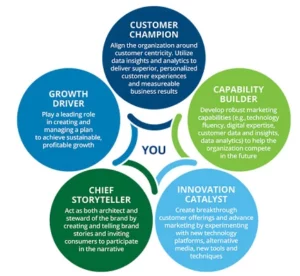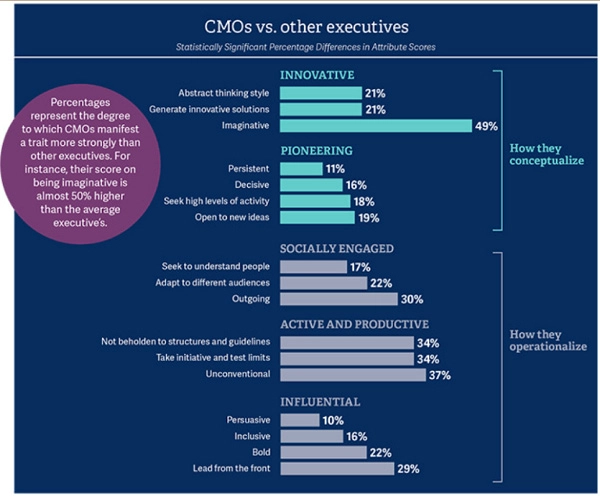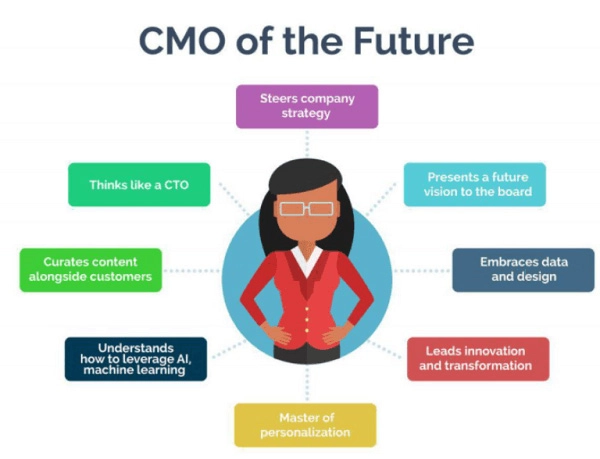
Introduction
The overwhelming prevalence of digitalization is constantly transforming the field of marketing. At nearly every turn, marketing pursuits look vastly different in style, scope, and execution than they did just a few years ago.
The Chief Marketing Officers (CMOs) have always been at the forefront of these transformations.
While the leaders of the organization craft the vision, message and strategy of companies, CMOs steer the business forward. And they do all of this amidst constant disruptions in marketing, technology and customer behavior.
In this article we’ll explore what’s the CMO mindset and what are the responsibilities that the title brings with it.
What Are The Primary Responsibilities Of A CMO?
According to the Forbes article “The 2 Primary Responsibilities Of A CMO” by Julian Villanueva, the core responsibilities of a CMO revolve around two things.
They are strategy and sales and are based on the importance of the holistic and contextual aspect of marketing.
Value cannot be created by marketers alone.
There’s marketing analysis, marketing thinking, and marketing decisions to be made before any marketing campaign is launched.
Plus, these fundamental decisions cannot be handled by one department only. Every department is a part of marketing the products and services of a company, whether they explicitly contribute to it or not.
The sales department markets the values of the company through the way they talk to and treat their customers. The production or development team, likewise, has to take inputs from the customer’s feedback and what they are saying to constantly improve the product/service.
Now, if so many people are involved in the puzzle, there has to be someone who brings everything together, asks smart questions, and helps everyone in the team see the bigger picture.
Marketing is thus holistic, and CMO helps make it so.
Another characteristic of marketing is that it’s highly contextual. That is, marketing theories that work in one context may not work in another. What works in B2B Tech or enterprise software marketing might be very different from a CPG everyday product.
While the former has a longer sales cycle, the latter might not. One is chiefly sales drives, especially if it’s a high-end product, while the other relies more on marketing and so on.
These two characteristics of marketing (holistic and contextual) make CMOs oversee the various marketing and sales responsibilities in 4 different ways, which include:
- Revenue Generator, ensuring the revenue targets are met on time.
- Driver of Growth, making most direct sales and marketing strategy decisions.
- Supporter, not being directly involved in these two responsibilities but supporting others who have them, like managing the sales team.
- Strategy Formulator, setting the marketing strategy right.
What Makes Them The Heart Of Their Businesses?

(Source: Deloitte)
The field of marketing has always been an unpredictable one, especially in the last couple of years, as technology and consumer attitudes have shifted drastically. Therefore, it’s difficult to nail down the exact responsibilities of a Chief Marketing Officer (CMO).
However, for sure, as the spearhead of the marketing team, a CMO can make or break a company.
Roles of a CMO in an Organization
- CMO Steers Company Strategy
- CMO Is The Brand’s Storyteller & Shapes Customer Perception
- CMO Thinks Like A CTO And Leads Innovation And Technology
1. CMO Steers Company Strategy
Customers are not always loyal; they quickly flock to better offerings that make their lives easier.
For example, when Uber surfaced, die-hard taxi customers didn’t hold on to the taxi industry, caring that it continues to thrive. Instead, customers dumped the taxi industry overnight for the no-fuss experience of Uber.
The CMO’s job is remarkable in light of the fact that the CMO knows the customer in a way no other official does. And the person who knows the customer in a way the CMO does needs to ultimately shift the company strategy. This is because profits follow companies that obsess over their customer behavior and focus on customer experience.
2. CMO Is The Brand’s Storyteller & Shapes Customer Perception
Communicating and sharing both internal and external stories is what helps fuel the growth of a company.
A CMO looks out for stories that articulate the company’s work and design philosophies.
He understands the entire customer lifecycle and knows what needs to be done to attract new customers, engage them, get them to buy, and keep them happy over the long term
Customer perception is the image the customer has of your brand, and there could be no other official that assumes a larger part in forming that client’s insight than the CMO himself.
3. CMO Thinks Like A CTO And Leads Innovation And Technology
With digitalization, an increasing number of customers are being assisted by technology each day. Therefore, a company’s ability to transform digitally is what determines its future success. So today, the large brands are curating the brand – and its content – alongside its customers.
The CMO is responsible for steering digital transformations. He is the person most involved in customer strategy and increasingly owns all customer programs. That said, it is the CMO’s responsibility to understand how and when to use new technologies.
He is the one to identify opportunities to enable teams to work faster with technology, not just in marketing but across the organization.
Markets keep evolving with time and customer needs, but today they are moving faster than at any point in history. That demands that CMOs are not only ready to see what’s coming round the corner but are also able to anticipate the customer needs since personalization and tailored interactions are the longer terms of customer experience.
A CMO – the person that holds the key to the customer’s heart and mind, must know how to think like a CTO to build and drive these experiences.
Which Traits Do They Demonstrate?
CMOs influence a broad range of business operations. While their success can’t be reduced to a formula, there are some traits that these top marketing executives share.
Let’s know it straight in their own words :
1. Curiosity
As a marketer, you have to be driven by the consumer that you are serving, and you can only do that when you are insanely curious about them. You can’t change the world if you are not curious about it.
– Jeff Jones, former CMO at Target
2. Open-Minded
The world is changing so fast, particularly from a marketing standpoint, that if you’re not interested in learning new things, you’ll be left in the dust very quickly.
– Doug Collier, former CMO at La-Z-Boy
3. Brave
(Risk-taking comes as a part of their profession)
Sometimes you scrape your knee, and a platform goes away, but I’d say it’s a greater risk not to be there trying it because in this world you don’t know what’s going to necessarily take off.
– Linda Boff, CMO at General Electric
4. Storyteller
They (humans) want to know history. They want to understand the authenticity and integrity of a brand. And maybe equally importantly, they want to share that backstory with others because it gives them inherent credibility.
– Lee Applbaum, CMO at Patron
5. Tech Trend Watcher
When you hear marketing, most people think of advertising. While we, of course, do that, we have made sure that marketing has been redefined as innovation. We expect our marketers to be the champions of ‘what’s next.’
– Beth Comstock, Vice Chair at General Electric
6. Revenue Focused
My team is doubling our commitment on marketing sourced pipeline year over year, without doubling the investment. This is a big North star for us, and the only way we can achieve this is by getting crystal clear, down to a finite level, the performance of everything we do.
– Carrie Palin, CMO & SVP at Box
What Makes CMOs Different From Other C -suite Figures?

(Source : Converge )
Compared with other figures in the top management, the chief marketing officer has obvious extreme leadership and behavior characteristics.
They Differ From Ordinary Administrative Staff In Many Attributes.
1. Innovative & Pioneering Spirit
The first set of attributes focuses on the innovation and pioneering spirit of the CMO. The behavior of CMOs is unconventional; they test limits and are not constrained by structure. These characteristics are very consistent with the traditional standard image of CMO.
2. Work In An Active & Productive Fashion
The second set of attributes explains how these innovators succeed in action: they use their strong social orientation and persuasive strategies to operate in a very active and productive way.
Wrapping Up

(Source: Forbes)
The roles and responsibilities of a CMO keep transforming with time and technology. But it basically revolves around sales & strategy, and they usually add value in their organizations as a – revenue generator, driver of growth, supporter, or strategy formulator.
From managing the brand and marketing plan to acting as a revenue driver across the company, digging into the hearts and minds of customers, the role of the CMO has expanded. Now it even includes sustainable growth, a highly personalized customer experience, and advanced marketing innovation.
Top CMOs push boundaries and look for the best solutions for their teams and customers — even if that means picking new or lesser-known options. They stay away from the herd when necessary to help their company stand out and dominate.
Our blog
Latest blog posts
Tool and strategies modern teams need to help their companies grow.

B2B companies must generate leads that are ready to buy their products in order to me...

In the absence of a constant flow of leads, sales teams can't meet their targets and ...

Podcasts and webinars are powerful tools that marketers can use to reach new audience...



